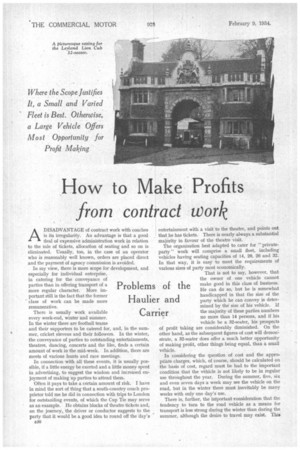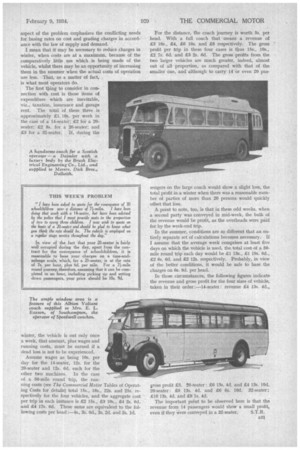How to Make Profits from contract work
Page 88

Page 89

If you've noticed an error in this article please click here to report it so we can fix it.
ADISADVANTAGE of contract work with coaches is its irregularity. An advantage is that a good deal of expensive administration work in relation to the sale of tickets, allocation of seating and so on is eliminated. Usually, too, in the case of an operator who is reasonably well known, orders are placed direct and the payment of agency commission is avoided.
In my view, there is more scope for development, and especially for individual enterprise, in catering for the conveyance of parties than in offering transport of a more regular character. More important still is the fact that the former class of work can be made more remunerative.
There is usually work available every week-end, winter and summer. In the winter there are football teams and their supporters to be catered for, and, in the summer, cricket elevens and their followers. In the winter, the conveyance of parties to outstanding entertainments, theatres, dancing, concerts and the like, finds a certain amount of work in the mid-week. In addition, there are meets of various hunts and race meetings.
In connection with all these events, it is usually possible, if a little energy be exerted and a little money spent in advertising, to suggest the wisdom and increased enjoyment of making up parties to attend them.
Often it pays to take a certain amount of risk. I have in mind the sort of thing that a south-country coach proprietor told me he did in connection with trips to London for outstanding events, of which the Cup Tie may serve as an example. He obtains blocks of theatre tickets and, on the journey, the driver or conductor suggests to the party that it would be a good idea to round off the day's
entertainment with a visit to the theatre, and points out that he has tickets. There is nearly always a substantial majority in favour of the theatre visit.
The organization best adapted to cater for " privateparty " work will comprise a small fleet, including vehicles having seating capacities of 14, 20, 26 and 32. In that way, it is easy to meet the requirements of various sizes of party most economically.
That is not to say, however, that the owner of one vehicle cannot make good in this class of business. He can do so, but he is somewhat handicapped in that the size of the party which he can convey is determined by the size of his vehicle. lf the majority of these parties numbers no more than 14 persons, and if his vehicle be a 32-seater, his prospects of profit taking are considerably diminished. On the other hand, as the subsequent figures of cost will demon: strate, a 32-seater does offer a much better opportunity a making profit, other things being equal, than a small vehicle.
In considering the question of cost and the appropriate charges, which, of course, should be calculated on the basis of cost, regard must be had to the important condition that the vehicle is not likely to be in regular use throughout the year. During the summer, five, six and even seven days a week may see the vehicle on the road, but in the winter there must inevitably be many weeks with only one day's use.
There is, further, the iniportant consideration that the tendency to turn to the road vehicle as a means for transport is less strong during the winter than during the summer, although the desire to travel may exist. This
aspect of the problem emphasizes the conflicting needs for basing rates on cost and grading charges in accord ance with the law of supply and demand.
I mean that it may be necessary to reduce charges in winter, when costs are at a maximum, because of the comparatively little use which is being made of the vehicle, whilst there may be an opportunity of increasing them in the summer when the actual costs of operation are less. That, as a matter of fact, is what most operators do.
The first tbing to consider in con nection with cost is those items of expenditure which are inevitable, viz., taxation, insurance and garage rent. The total of these three is approximately EL 10s. per week in the case of a 14-seater; £2 for a 20seater; £2 8s. for a 26-seater; and ES for a 32-seater. If, during the winter, the vehicle is out only once a week, that amount, plus wages and running costs, must be earned if a dead loss is not to be experienced.
Assume wages as being 10s. per day for the 14-seater, 12s. for the 20-seater and 12s. 6d. each for the other two machines. In the case of a 50-mile round trip, the run
ning costs (see The Commercial Motor Tables of Operat
ing Costs for details) total 15s., 18s., 22s. and 25s. respectively for the four vehicles, and the aggregate cost
per trip in each instance is £2 I5s., 13 10s., E4 2s. 6d. and £4 17s. 6d. These sums are equivalent to the following costs per head :-4s., 3s. 64,, 3s. 2d. and 3s. id.
For the distance, the coach journey is worth 5s. per head. With a full coach that means a revenue of £3 10s., £4, £6 10s. and 18 respectively. The gross profit per trip in these four cases is thus 15s., 10s., £2 7s. 6d. and E.3 2s. 6d. The gross profits from the two larger vehicles are much greater, indeed, almost out of all proportion, as compared with that of the smaller one, and although to carry 14 or even 20 pas sengers on the large coach would show a slight loss, the total profit in a winter when there was a reasonable number of parties of more than 20 persons would quickly offset that loss.
A point to note, too, is that in these odd weeks, when a second party was conveyed in mid-week, the bulk of the revenue would be profit, as the overheads were paid for by the week-end trip.
In the summer, conditions are SO different that an entirely separate set of calculations becomes necessary. If I assume that the average week comprises at least five days on which the vehicle is used, the total cost of a 50mile round trip each day would be Al 13s., El 19s. 6d., £2 6s. 6d. and £2 12s. respectively. Probably, in view of the better conditions, it would be safe to base the charges on 6s. 8d. per head.
In those circumstances, the following figures indicate the revenue and gross profit for the four sizes of vehicle, taken in their order :-14-seater : revenue £4 13s. 4d., gross profit E3. 20-seater : E6 13s. 4d. and £4 13s. 10d. 26-seater : £8 13s. 44. and E6 6s. 10d.' 32-seater: E10 13s. 4d. and £8 Is. 4d.
The important point to be observed here is that the revenue from 14 passengers would show a small profit, even if they were conveyed in a 32-seater. S.T.R.




































































































































































